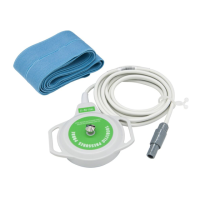Cadence II Fetal Monitor Service Manual
- 47 -
⑥ Insert connector of fetal ECG cable into the DECG socket on the monitor.
⑦ Check the setup of DECG arrhythmia logic.
The transient heart rate change that equals to or is greater than ±25bpm is not recorded
when enabling the DECG arrhythmia logic (The DECGAntiArt at the menu is set to ON).
The recording will resume when beat drops within the limits.
The monitor will display all the recorded fetal heart beats when disconnecting DECG
arrhythmia logic (The DECGAntiArt at the menu is set to OFF). If you have doubts about
arrhythmia of the fetus, disconnect the DECG arrhythmia logic.
Prepare the Patient's Skin Prior to Placing Electrodes
The skin is a poor conductor of electricity, therefore preparation of the patient's skin is
important to facilitate good electrode contact to skin.
Z Shave hair from sites, if necessary.
Z Wash sites thoroughly with soap and water (Never use ether or pure alcohol,
because this increases skin impedance).
Z Rub the skin briskly to increase capillary blood flow in the tissues and remove skin
scurf and grease.
Detach Fetal Spiral Electrode
To detach the fetal spiral electrode, rotate it counterclockwise until it is free from the fetal
presenting part. Do not pull the electrode from the fetal skin.
CAUTION : Do not mistake the higher maternal heart rate for fetal heart rate.
Notes: ① If the DECG arrhythmia logic is disconnected during monitoring, remember
to connect it later.
② If there is any doubt as to the presence of a fetal heart signal with ECG,
check with the ultrasound transducer on the mother or with a separate
diagnostic instrument. The presence of an audible Doppler heart sound at a
rate distinct from that of the maternal pulse is unequivocal evidence of fetal
life.
③ After connection of electrodes a few minutes should be allowed for
stabilization of the electrode and fetal tissue. It is essential that the ECG
signal electrode is in good contact with the fetal presenting part.
Directions for Use of Fetal Spiral Electrode
① Remove from package, leaving the electrode wires locked in the handle notch.
② Gently form the guide tube to the desired angle.
③ With the patient in the dorsal lithotomy position, perform a vaginal examination and

